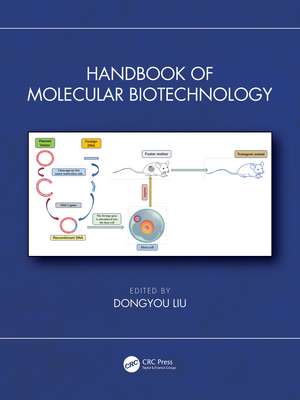Handbook of Molecular Biotechnology
Editat de Dongyou Liuen Limba Engleză Hardback – 5 sep 2024
While molecular biotechnology offers unlimited opportunities for improving human health and well-being, animal welfare, agricultural innovation and environmental conservation, a dearth of high quality books that have the clarity of laboratory manuals without distractive procedural details and the thoroughness of well-conversed textbooks appears to dampen the enthusiasm of aspiring students. In attempt to fill this glaring gap, Handbook of Molecular Biotechnology includes four sections, with the first three presenting in-depth coverage on DNA, RNA and protein technologies, and the fourth highlighting their utility in biotechnology. Recognizing the importance of logical reasoning and experimental verification over direct observation and simple description in biotechnological research and development, the Introduction provides pertinent discussions on key strategies (i.e., be first, be better, and be different), effective thinking (lateral, parallel, causal, reverse, and random), and experimental execution, which have proven invaluable in helping advance research projects, evaluate and prepare research reports, and enhance other scientific endeavors.
Key features
- Presents state-of-the-art reviews on DNA, RNA and protein technologies and their biotechnological applications
- Discusses key strategies, effective thinking, and experimental execution for scientific research and development
- Fills the gap left by detailed-ridden laboratory manuals and insight-lacking standard textbooks
- Includes expert contributions from international scientists at the forefront of molecular biotechnology research and development
Preț: 1841.90 lei
Preț vechi: 2471.05 lei
-25% Nou
Puncte Express: 2763
Preț estimativ în valută:
352.45€ • 384.39$ • 297.19£
352.45€ • 384.39$ • 297.19£
Carte tipărită la comandă
Livrare economică 24 aprilie-08 mai
Preluare comenzi: 021 569.72.76
Specificații
ISBN-13: 9780367517878
ISBN-10: 0367517876
Pagini: 762
Ilustrații: 196
Dimensiuni: 210 x 280 mm
Greutate: 1.56 kg
Ediția:1
Editura: CRC Press
Colecția CRC Press
Locul publicării:Boca Raton, United States
ISBN-10: 0367517876
Pagini: 762
Ilustrații: 196
Dimensiuni: 210 x 280 mm
Greutate: 1.56 kg
Ediția:1
Editura: CRC Press
Colecția CRC Press
Locul publicării:Boca Raton, United States
Public țintă
Postgraduate, Professional, and Undergraduate AdvancedCuprins
1. Molecular biotechnology: from past achievements to future breakthroughs. Section I DNA Technologies. 2. DNA structure and function. 3. DNA purification. 4. DNA amplification. 5. DNA sequencing. 6. DNA cloning vectors. 7. DNA cloning. 8. DNA mutagenesis. 9. CRISPR/Cas9-mediated genome editing: Current status. 10. DNA epigenetic modifications. Section II RNA Technologies. 11. RNA structure and function. 12. RNA purification. 13. RNA amplification. 14. In vitro RNA transcription. 15. RNA sequencing. 16. RNA cloning. 17. RNA interference. 18. RNA modifications. Section III Protein Technologies. 19. Protein structure and function. 20. Protein purification. 21. Protein sequencing. 22. Cell free gene expression. 23. Protein expression. 24. Polyclonal antibodies. 25. Monoclonal antibodies. 26. Recombinant antibodies. 27. Protein modification. 28. Protein-protein interactions: A technical overview. 29. Protein-DNA interaction. 30. Protein-RNA interaction. 31. Protein-lipid interaction. 32. Protein-carbohydrate interaction. Section IV Molecular Approaches to Biotechnology. Diagnostics. 33. Molecular systematics. 34. Nucleic acid diagnostics. 35. Immunodiagnostics. 36. Mutation detection. 37. Molecular epidemiology. 38. Antimicrobial resistance: Causes, mechanisms, origins and characterizatio. 39. Biofilms and their impact on human health: the beauty and the beast. 40. Microbiome. 41. Genomics. 42. Transcriptomics. 43. Proteomics. 44. Harnessing dynamic metabolomics for bioprocess prediction and beyond. 45. Biosensors. Therapeutics. 46. Probiotics and prebiotics. 47. Dietary supplements. 48. Vaccines. 49. Phage therapy: A clinician’s guide. 50. Gene therapy. 51. Stem cell therapy. 52. Immuno- and targeted-therapies for cancer. 53. Biocontrol and bioremediation. Miscellaneous applications. 54 Forward and reverse genetics. 55. Genetically modified bacteria: History, principle, and utility. 56. Genetically modified Caenorhabditis elegans as an experimental model. 57. Genetically modified Drosophila melanogaster as an experimental model. 58. Genetically modified zebrafish as an experimental model. 59. In vitro tissue engineering. 60. Transgenic animals. 61. Transgenic plants. 62. Bioinformatics.
Notă biografică
Dongyou Liu, Ph.D., studied veterinary science at Hunan Agricultural University, China and conducted postgraduate research on the generation and application of monoclonal antibodies for improved immunodiagnosis of human hydatidosis at The University of Melbourne, Australia. In the past three decades, he has worked at several research and clinical laboratories in Australia and the United States of America, with focuses on molecular characterization of microbial pathogens and detection of human genetic disorders and tumors/cancers. He is the first author of >50 original research and review articles in peer-reviewed international journals, the contributor of 294 book chapters, and the editor of Handbook of Listeria monocytogenes (2008), Handbook of Nucleic Acid Purification (2009), Molecular Detection of Foodborne Pathogens (2009), Molecular Detection of Human Viral Pathogens (2010), Molecular Detection of Human Bacterial Pathogens (2011), Molecular Detection of Human Fungal Pathogens (2011), Molecular Detection of Human Parasitic Pathogens (2012), Manual of Security Sensitive Microbes and Toxins (2014), Molecular Detection of Animal Viral Pathogens (2016), Laboratory Models for Foodborne Infections (2017), Pocket Guides to Biomedical Sciences: Tumors and Cancers – Central and Peripheral Nervous Systems (2017), Pocket Guides to Biomedical Sciences: Tumors and Cancers – Head, Neck, Heart, Lung and Gut (2017), Pocket Guides to Biomedical Sciences: Tumors and Cancers – Skin, Soft Tissue, Bone and Urogenitals (2017), Pocket Guides to Biomedical Sciences: Tumors and Cancers – Endocrine glands, Blood, Marrow and Lymph (2017), Handbook of Foodborne Diseases (2018), Handbook of Tumor Syndromes (2020), and Molecular Food Microbiology (2021), all of which are published by CRC Press. He is also a co-editor for Molecular Medical Microbiology, 2nd edition (2014), and Molecular Medical Microbiology, 3rd edition (2023), which are released by Elsevier.
Descriere
While molecular biotechnology offers opportunities for improving human health, animal welfare, agricultural innovation and environmental conservation, a dearth of high quality books that have the clarity of laboratory manuals without the thoroughness of well-conversed textbooks appears to damp the enthusiasm of aspiring students.
